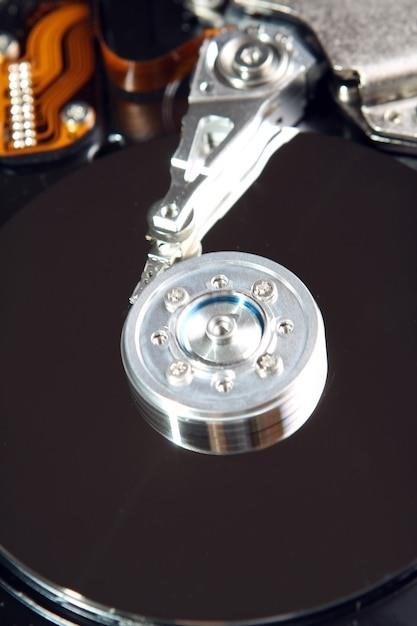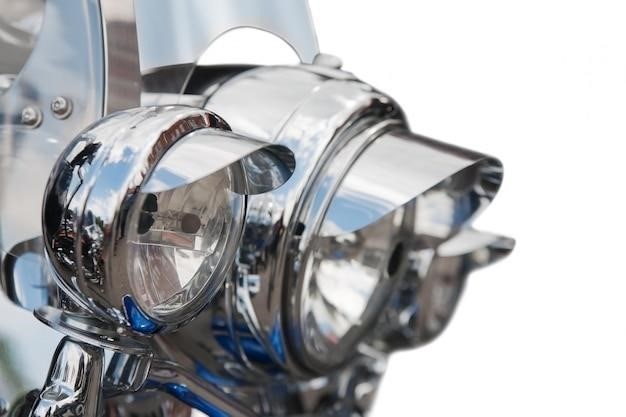Allen & Heath GL2400⁚ A Comprehensive Guide
This guide delves into the intricacies of the Allen & Heath GL2400 mixing console, a popular choice for professional audio applications. We’ll explore its key features, channel strip functionalities, mixing and routing capabilities, aux sends and returns, matrix mixer, EQ and dynamics, monitoring and headphones, troubleshooting tips, and maintenance recommendations. Whether you’re a seasoned sound engineer or just starting out, this guide provides a comprehensive overview to help you master this versatile mixing console.

Introduction to the Allen & Heath GL2400
The Allen & Heath GL2400 is a renowned 4-bus dual-function analog mixing console designed for professional audio applications. Its versatility makes it suitable for a wide range of scenarios, from live sound reinforcement and studio recording to installation in busy venues and touring applications. This console boasts a robust design, offering dependable performance and precise control over audio signals. It’s a workhorse in the audio industry, known for its reliability and ability to deliver high-quality sound.
The GL2400 series includes models with varying channel counts, such as the GL2400-16, GL2400-24, GL2400-32, and GL2400-40. Each model offers a comprehensive set of features tailored to specific needs. The GL2400’s popularity stems from its user-friendly interface, powerful processing capabilities, and ability to handle a wide variety of audio signals.
This manual serves as your guide to unlocking the full potential of the GL2400. It covers essential aspects of its operation, from basic setup and connectivity to advanced mixing techniques and troubleshooting. Whether you’re a seasoned sound engineer or just starting out, this document will equip you with the knowledge and skills to confidently utilize this versatile mixing console.
Key Features and Specifications
The Allen & Heath GL2400 is packed with features designed to meet the demands of professional audio applications. Here’s a breakdown of its key specifications and capabilities⁚
- Dual Function⁚ The GL2400 excels as both a front-of-house (FOH) and monitor mixing console, allowing you to manage both main and stage sound seamlessly.
- Channel Count⁚ The GL2400 series offers models with varying channel counts, including 16, 24, 32, and 40 channels. Choose the model that best suits your specific needs.
- 4-Bus Architecture⁚ The console features four main output busses, providing flexibility for routing signals to different destinations, such as the main mix, monitor mixes, and recording outputs.
- 6 Aux Sends⁚ The GL2400 includes six aux sends, enabling you to send signals to external effects processors or create separate mixes for monitoring or recording.
- 7×4 Matrix Mixer⁚ The console’s matrix mixer allows you to route signals from any input to any output, providing extensive routing flexibility.
- 4-Band EQ⁚ Each input channel features a 4-band equalizer, giving you precise control over the tonal characteristics of your audio signals.
- Dynamics Processing⁚ Input channels include built-in dynamics processors, allowing you to shape the dynamic range of your audio signals with compression and limiting functions.
- Monitoring Options⁚ The GL2400 provides a dedicated headphone output for monitoring and a comprehensive set of monitor outputs for stage monitoring.
- Syslink Capability⁚ The GL2400 supports Allen & Heath’s Syslink system, enabling you to link multiple consoles for larger-scale audio setups.
These features combine to create a powerful and versatile mixing console that can handle a wide range of audio tasks with precision and efficiency.
Channel Strip Overview
The heart of the Allen & Heath GL2400 lies in its individual channel strips, each offering a comprehensive set of controls for shaping and routing audio signals. Here’s a detailed look at the channel strip layout⁚
- Input Gain⁚ The input gain control allows you to adjust the signal level from your microphone or line input to achieve optimal levels for the console’s internal processing.
- 48V Phantom Power⁚ A dedicated switch provides 48V phantom power for powering condenser microphones.
- High-Pass Filter⁚ The high-pass filter removes low-frequency noise, such as rumble or wind noise, from your audio signals.
- 4-Band Equalizer⁚ A 4-band equalizer (40Hz, 100Hz, 800Hz, and 12kHz) provides precise control over the tonal characteristics of your audio signals, allowing you to shape the frequency response to your liking.
- Pre/Post EQ Switch⁚ This switch determines whether the equalizer affects the signal before or after the channel’s dynamics processor, enabling you to apply EQ to your audio signals in different ways.
- Dynamics Processor⁚ The dynamics processor features compression and limiting functions, allowing you to control the dynamic range of your audio signals, ensuring a consistent level and preventing clipping.
- Aux Sends⁚ Each channel features individual aux send controls, allowing you to route the signal to external effects processors or create separate mixes for monitoring or recording.
- Pan Pot⁚ The pan pot allows you to adjust the stereo position of the signal across the stereo output busses.
- Fader⁚ The fader controls the overall level of the channel, allowing you to adjust its volume in the final mix.
- Mute Switch⁚ The mute switch silences the channel, providing a quick and easy way to temporarily disable individual inputs.
- Insert Point⁚ The insert point allows you to connect external processing devices, such as outboard equalizers, compressors, or effects units, directly into the channel signal path.
The channel strip layout offers a comprehensive set of tools for shaping, routing, and processing individual audio signals, making it a powerful and versatile tool for sound engineers.
Mixing and Routing
The Allen & Heath GL2400 excels in its mixing and routing capabilities, offering a flexible platform for crafting professional-grade audio mixes. Its design facilitates a wide range of routing options, allowing you to create diverse mixes for various applications, including live sound reinforcement, studio recording, and broadcast. Let’s delve into the key aspects of mixing and routing on the GL2400⁚

- Main Mix⁚ The GL2400 features a main mix section, providing a dedicated area for controlling the final stereo output of your mix. It includes the left (L) and right (R) master faders for overall volume adjustment, as well as a mono sum output for creating a mono mix when needed.
- 4-Bus Architecture⁚ The console features a 4-bus architecture, giving you four independent mix buses (1-4) for routing specific groups of channels. This allows you to create separate mixes for different applications, like sub-mixes for monitor feeds or separate mixes for recording;
- Aux Sends⁚ The GL2400 boasts six aux sends, providing ample flexibility for routing signals to external effects processors or creating dedicated mixes for monitoring or recording. You can choose to send signals pre- or post-fader, tailoring the routing to your specific needs.
- Matrix Mixer⁚ The GL2400 incorporates a 7×4 matrix mixer, offering extensive routing possibilities for your mix buses and aux sends. This allows you to easily route signals from any channel or mix bus to any of the aux sends or main mix outputs.
- Solo Function⁚ The solo function enables you to isolate individual channels or mix buses, allowing you to focus on specific audio signals during the mixing process.
- Cue System⁚ The GL2400 features a dedicated cue system, allowing you to create custom headphone mixes for monitoring purposes. This is particularly helpful for musicians who need to hear their own instruments or specific mixes during rehearsals or performances.
The GL2400’s mixing and routing capabilities empower you to create complex and intricate mixes with ease. Its flexible design caters to various audio production workflows, making it a suitable choice for a wide range of applications.
Aux Sends and Returns
The Allen & Heath GL2400’s aux sends and returns play a crucial role in expanding its functionality and offering a variety of creative audio processing options. These features allow you to route signals to external effects processors, create custom monitor mixes, and even record multiple tracks simultaneously. Let’s explore how aux sends and returns enhance your audio production capabilities on the GL2400⁚
- Aux Sends⁚ The GL2400 provides six aux sends, each with its own dedicated level control. These sends allow you to route individual channel signals, or groups of channels, to external effects processors or other destinations. You have the flexibility to choose whether you want to send the signal pre-fader (before the channel fader) or post-fader (after the channel fader). Pre-fader sends are useful for sending signals to effects processors, while post-fader sends are typically used for creating monitor mixes or recording multiple tracks.
- Aux Returns⁚ The GL2400 features dedicated aux returns for each of the six aux sends. These returns bring the processed signals from external effects processors back into the mix; The return channels have their own level controls, allowing you to adjust the volume of the processed signals within the mix. The GL2400 also allows you to assign the aux returns to different mix buses, providing flexibility for routing the processed signals to different destinations.
- Monitor Mixes⁚ Aux sends are often used for creating custom monitor mixes for musicians on stage. By sending signals from specific channels to dedicated aux sends, you can create separate mixes for each musician, allowing them to hear their own instruments or specific mixes within the overall mix.
- Recording Multi-Track⁚ The aux sends can also be used for recording multiple tracks simultaneously. By sending signals from different channels to different aux sends and then recording each aux send to a separate track, you can create a multi-track recording of your performance.
The GL2400’s aux sends and returns offer a versatile set of tools for enhancing your audio production workflow. Whether you’re using them for effects processing, creating monitor mixes, or recording multiple tracks, these features provide a flexible and powerful way to shape your sound.
Matrix Mixer
The Allen & Heath GL2400’s matrix mixer is a powerful feature that enhances routing flexibility, allowing you to send signals to multiple destinations simultaneously. This functionality is particularly useful for creating custom monitor mixes, distributing signals to various zones in a venue, or even recording multiple tracks from different sources. Let’s explore how the matrix mixer empowers your audio production capabilities on the GL2400⁚
- 7×4 Matrix⁚ The GL2400 features a 7×4 matrix, providing seven input sources and four output destinations. This allows you to send any combination of the seven input sources to any of the four outputs. The input sources include the main stereo mix, the four aux sends, and two additional stereo inputs (stereo channel line in). The output destinations are typically used for monitor mixes, zone outputs, or recording outputs.
- Flexible Routing⁚ The matrix mixer offers a high level of routing flexibility, allowing you to send signals to multiple destinations simultaneously. For example, you can send the main stereo mix to a monitor mix for the band, the aux send 1 to a zone output for the bar area, and the stereo channel line in to a recording output. The possibilities are endless, and the matrix mixer allows you to create custom routing configurations to suit your specific needs.
- Custom Monitor Mixes⁚ The matrix mixer is particularly useful for creating custom monitor mixes for musicians on stage. You can send specific signals from the main mix, aux sends, or stereo channel line in to different monitor mixes, allowing you to create unique mixes for each musician. This ensures that each musician can hear the specific signals they need, while minimizing unwanted noise or feedback.
- Zone Outputs⁚ The matrix mixer can also be used to distribute signals to different zones in a venue. For example, you can send the main stereo mix to the main PA system, aux send 2 to a zone output for the bar area, and aux send 3 to a zone output for the dance floor. This allows you to control the audio in different areas of the venue independently, providing flexibility for background music, announcements, or dedicated sound systems for specific areas.
The GL2400’s matrix mixer is a powerful tool that expands your routing options and enables you to create custom configurations for a variety of audio applications. Whether you’re creating monitor mixes, distributing signals to different zones, or recording multiple tracks, the matrix mixer provides the flexibility and control you need to achieve your desired sound.
EQ and Dynamics
The Allen & Heath GL2400 offers robust EQ and dynamics processing on each channel strip, providing the tools you need to shape and refine your audio signals. Whether you’re tackling unwanted frequencies, adding warmth and presence, or controlling dynamic range, the GL2400’s EQ and dynamics sections provide the flexibility to achieve your desired sound.
- 4-Band EQ⁚ Each channel strip features a 4-band EQ, comprising two semi-parametric midrange bands and high and low shelving filters. The semi-parametric midrange bands allow you to adjust frequency and Q (bandwidth) for precise control over specific frequencies. The shelving filters provide a gentle slope for boosting or attenuating high and low frequencies, adding warmth, presence, or tightening the bottom end.
- High-Pass Filter⁚ The GL2400 also includes a high-pass filter on each channel strip, which allows you to remove unwanted low-frequency content. This is particularly useful for eliminating rumble or low-frequency noise from microphones, instruments, or recordings. The high-pass filter helps to clean up the signal and improve overall clarity.
- Dynamics⁚ The GL2400 provides built-in dynamics processing on each channel strip, including a compressor and gate. The compressor allows you to control the dynamic range of a signal, reducing the volume of loud peaks while boosting quieter sections. This helps to even out the overall volume and provide a more consistent signal level. The gate acts as a noise reduction tool, automatically silencing the signal when it falls below a certain threshold. This can be helpful for eliminating unwanted noise or hiss from microphones or instruments.
- Precise Control⁚ The GL2400’s EQ and dynamics sections offer a high level of control, allowing you to shape and refine your audio signals with precision. The semi-parametric midrange EQ bands, adjustable Q, and high-pass filter provide the flexibility to target specific frequencies and achieve desired tonal characteristics. The compressor and gate offer adjustable thresholds, ratios, and attack and release times, allowing you to tailor their effects to suit the specific needs of each signal.
The combination of EQ and dynamics processing on the GL2400 empowers you to sculpt and refine your audio signals, bringing clarity, presence, and control to your mixes. Whether you’re addressing unwanted frequencies, shaping the tonal balance, or managing dynamic range, the GL2400 provides the tools to achieve professional-quality results.



























